
The large spiral galaxy next door
Although several dozen minor galaxies lie closer to our Milky Way, the Andromeda galaxy is the closest large spiral galaxy to ours. Excluding the Large and Small Magellanic Clouds, visible from Earth’s Southern Hemisphere, the Andromeda galaxy is the brightest external galaxy you can see. At 2.5 million light-years, it’s the most distant thing humans can see with the unaided eye.
Astronomers sometimes call this galaxy Messier 31, or M31. It was the 31st on a famous list of fuzzy objects compiled by the French astronomer Charles Messier (1730-1817). His catalog listed “objects to avoid” when comet-hunting. Nowadays, amateur astronomers seek out these objects with their telescopes and binoculars. They’re some of most beautiful deep-sky objects known.
Most Messier objects are star clusters or gas clouds in our Milky Way galaxy. But the Andromeda galaxy is a whole separate galaxy, even bigger than our Milky Way. In a dark sky, you can see that it’s big on the sky as well, a smudge of distant light larger than a full moon.
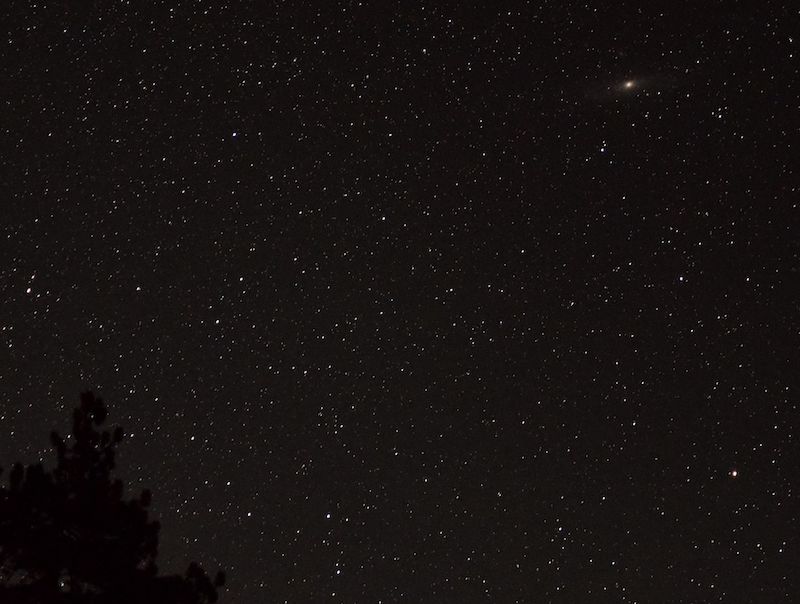
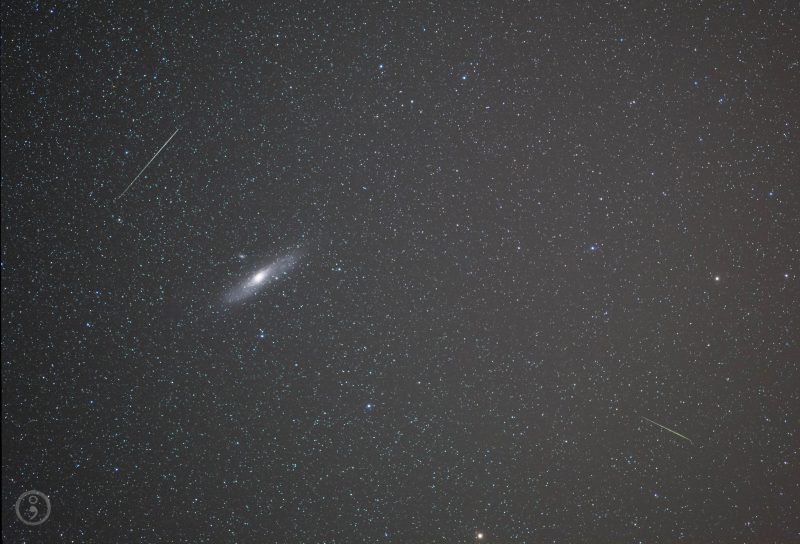
When to look for it
From mid-northern latitudes, you can see Andromeda – M31 – for at least part of every night, all year long. But most people see the galaxy first around August or September, when it’s high enough in the sky to be seen from evening until daybreak.
In late August and early September, begin looking for the galaxy in mid-evening, about midway between your local nightfall and midnight.
In late September and early October, the Andromeda galaxy shines in your eastern sky at nightfall, swings high overhead in the middle of the night, and stands rather high in the west at the onset of morning dawn.
Winter evenings are also good for viewing the Andromeda galaxy.
If you are far from city lights, and you’re stargazing during a moonless night late at summer, autumn or winter, it’s possible that you’ll simply notice the galaxy there in your night sky. But if you don’t manage to easily see it, you can star-hop to find the galaxy in one of two ways. The easiest way is to use the constellation Cassiopeia the Queen. You can also use the Great Square of Pegasus.

2 ways to find the Andromeda galaxy
The constellation Cassiopeia is easy to find. Look generally northward on the sky’s dome for a pattern of stars shaped like the letter M or W. If you can recognize the North Star, Polaris – and if you know how to find the Big Dipper – be aware that the Big Dipper and Cassiopeia move around Polaris like the hands of a clock, always opposite each other.
Once you’ve found Cassiopeia, look for its star Schedar. In the illustration above, see how Schedar points to the Andromeda galaxy?
You can also star-hop to the Andromeda galaxy, using the Great Square of Pegasus. It’s a longer route. But, in many ways, it’s more beautiful.

You’ll be hopping to the Andromeda galaxy from the Great Square of Pegasus. In autumn, the Great Square of Pegasus looks like a great big baseball diamond in the eastern sky. Envision the bottom star of the Square’s four stars as home plate, then draw an imaginary line from the “1st base” star though the “3rd base” star to locate two streamers of stars flying away from the Great Square. These stars belong to the constellation Andromeda the Princess.
On each streamer, go two stars north (left) of the third base star, locating the stars Mirach and Mu Andromedae. Draw a line from Mirach through Mu Andromedae, going twice the Mirach/Mu Andromedae distance. You’ve just landed on the Andromeda galaxy, which looks like a smudge of light to the unaided eye.
If you can’t see the Andromeda galaxy with the eye alone, by all means use binoculars.
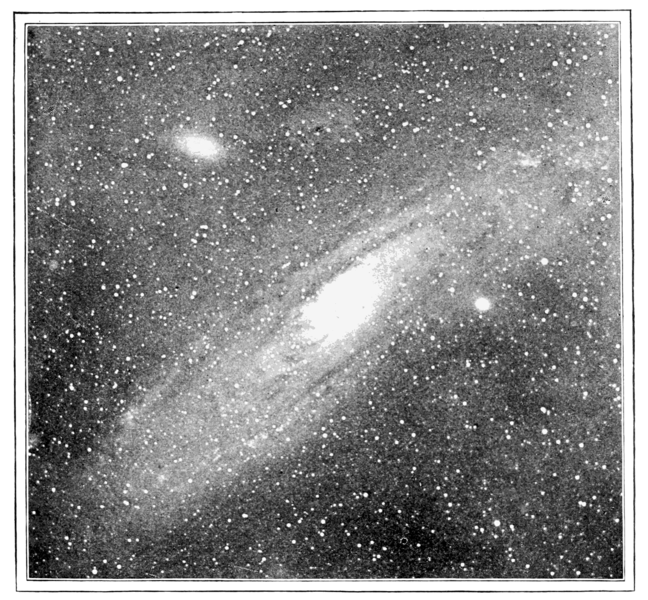
History of our knowledge of the Andromeda galaxy
At one time, the Andromeda galaxy was called the Great Andromeda Nebula. Astronomers thought this patch of light was composed of glowing gases, or was perhaps a solar system in the process of formation.
It wasn’t until the 20th century that astronomers were able to resolve the Andromeda spiral nebula into individual stars. This discovery lead to a controversy about whether the Andromeda spiral nebula and other spiral nebulae lie within or outside the Milky Way.
In the 1920s Edwin Hubble finally put the matter to rest, when he used Cepheid variable stars within the Andromeda galaxy to determine that it is indeed an island universe residing beyond the bounds of our Milky Way galaxy.
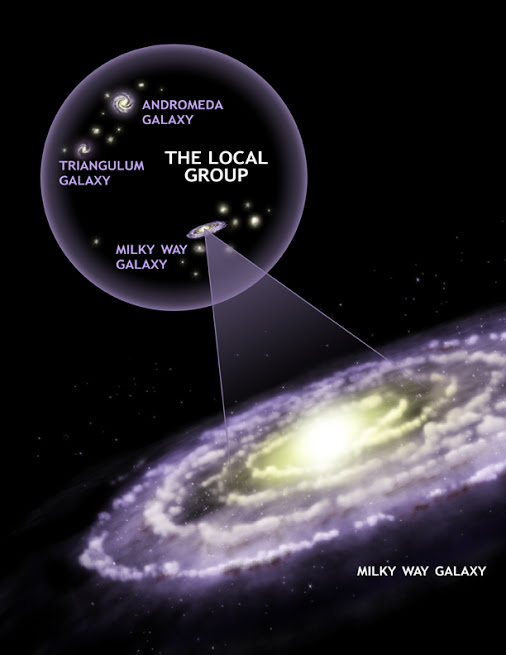
Andromeda and Milky Way in context
The Andromeda and Milky Way galaxies reign as the two most massive and dominant galaxies within the Local Group of Galaxies. The Andromeda Galaxy is the largest galaxy of the Local Group, which, in addition to the Milky Way, also contains the Triangulum Galaxy and about 30 other smaller galaxies.
Both the Milky Way and the Andromeda galaxies lay claim to about a dozen satellite galaxies. Both are some 100,000 light-years across, containing enough mass to make billions of stars.
Astronomers have discovered that our Local Group is on the outskirts of a giant cluster of several thousand galaxies, which astronomers call the Virgo Cluster.
We also know of an irregular supercluster of galaxies, which contains the Virgo Cluster, which in turn contains our Local Group, which in turn contains our Milky Way galaxy and the nearby Andromeda galaxy. At least 100 galaxy groups and clusters are located within this Virgo Supercluster. Its diameter is thought to be about 110 million light-years.
The Virgo Supercluster is thought to be one of millions of superclusters in the observable universe.

Will the Andromeda galaxy collide with the Milky Way?
One of you wrote:
I’ve heard that the Andromeda galaxy will someday collide with our galaxy! Is that still a definite possibility?
Definite possibility describes much of what we know – or think we know – about the universe. As for the Andromeda galaxy and its future collision with our Milky Way: the first attempt to measure the radial velocity of this galaxy (its motion forward or back, along our line of sight) was made in 1912. After that, astronomers believed for some decades that the galaxy was approaching at nearly 200 miles per second (300 km/s), but later astronomers disagreed.
Then in May 2012, NASA astronomers announced they can now predict the time of this collision of titan galaxies with certainty. Remember, though, that the Andromeda Galaxy is 2.2 million light-years away, with a single light-year being almost 10 trillion kilometers (6 trillion miles). So although it does appear that this galaxy is approaching our Milky Way galaxy … it’s nothing to lose sleep over. When will they collide? According to NASA astronomers in 2012, it’ll be four billion years from now.
Read more: Will the Milky Way and Andromeda galaxies collide someday?
When galaxies collide…
Plus when galaxies collide, they don’t exactly crash into each other. Because there’s so much more space than stars even in a galaxy, colliding galaxies pass through each other, like ghosts.
But, colliding galaxies do interact via gravity, which will cause them to change shape and even merge into a larger galaxy. Check out this cool video: Night sky as Milky Way and Andromeda galaxies merge.
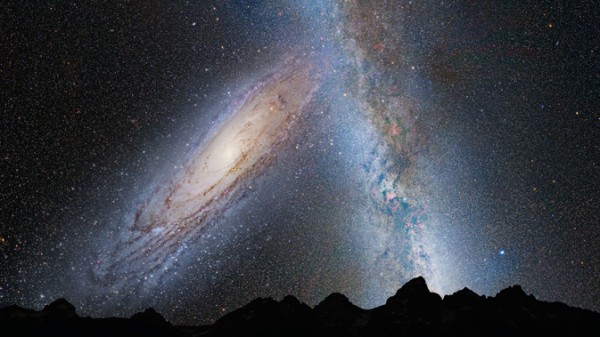
The Andromeda galaxy (M31) is located at the coordinates RA: 0h 42.7m; Dec: 41o 16′ north
Bottom line: At 2.5 million light-years, the great Andromeda galaxy (Messier 31) rates as the most distant object you can see with the unaided eye.
Enjoying EarthSky? Sign up for our free daily newsletter today!
The post Andromeda galaxy: All you need to know first appeared on EarthSky.
from EarthSky https://ift.tt/2WeZgOS

The large spiral galaxy next door
Although several dozen minor galaxies lie closer to our Milky Way, the Andromeda galaxy is the closest large spiral galaxy to ours. Excluding the Large and Small Magellanic Clouds, visible from Earth’s Southern Hemisphere, the Andromeda galaxy is the brightest external galaxy you can see. At 2.5 million light-years, it’s the most distant thing humans can see with the unaided eye.
Astronomers sometimes call this galaxy Messier 31, or M31. It was the 31st on a famous list of fuzzy objects compiled by the French astronomer Charles Messier (1730-1817). His catalog listed “objects to avoid” when comet-hunting. Nowadays, amateur astronomers seek out these objects with their telescopes and binoculars. They’re some of most beautiful deep-sky objects known.
Most Messier objects are star clusters or gas clouds in our Milky Way galaxy. But the Andromeda galaxy is a whole separate galaxy, even bigger than our Milky Way. In a dark sky, you can see that it’s big on the sky as well, a smudge of distant light larger than a full moon.


When to look for it
From mid-northern latitudes, you can see Andromeda – M31 – for at least part of every night, all year long. But most people see the galaxy first around August or September, when it’s high enough in the sky to be seen from evening until daybreak.
In late August and early September, begin looking for the galaxy in mid-evening, about midway between your local nightfall and midnight.
In late September and early October, the Andromeda galaxy shines in your eastern sky at nightfall, swings high overhead in the middle of the night, and stands rather high in the west at the onset of morning dawn.
Winter evenings are also good for viewing the Andromeda galaxy.
If you are far from city lights, and you’re stargazing during a moonless night late at summer, autumn or winter, it’s possible that you’ll simply notice the galaxy there in your night sky. But if you don’t manage to easily see it, you can star-hop to find the galaxy in one of two ways. The easiest way is to use the constellation Cassiopeia the Queen. You can also use the Great Square of Pegasus.

2 ways to find the Andromeda galaxy
The constellation Cassiopeia is easy to find. Look generally northward on the sky’s dome for a pattern of stars shaped like the letter M or W. If you can recognize the North Star, Polaris – and if you know how to find the Big Dipper – be aware that the Big Dipper and Cassiopeia move around Polaris like the hands of a clock, always opposite each other.
Once you’ve found Cassiopeia, look for its star Schedar. In the illustration above, see how Schedar points to the Andromeda galaxy?
You can also star-hop to the Andromeda galaxy, using the Great Square of Pegasus. It’s a longer route. But, in many ways, it’s more beautiful.

You’ll be hopping to the Andromeda galaxy from the Great Square of Pegasus. In autumn, the Great Square of Pegasus looks like a great big baseball diamond in the eastern sky. Envision the bottom star of the Square’s four stars as home plate, then draw an imaginary line from the “1st base” star though the “3rd base” star to locate two streamers of stars flying away from the Great Square. These stars belong to the constellation Andromeda the Princess.
On each streamer, go two stars north (left) of the third base star, locating the stars Mirach and Mu Andromedae. Draw a line from Mirach through Mu Andromedae, going twice the Mirach/Mu Andromedae distance. You’ve just landed on the Andromeda galaxy, which looks like a smudge of light to the unaided eye.
If you can’t see the Andromeda galaxy with the eye alone, by all means use binoculars.

History of our knowledge of the Andromeda galaxy
At one time, the Andromeda galaxy was called the Great Andromeda Nebula. Astronomers thought this patch of light was composed of glowing gases, or was perhaps a solar system in the process of formation.
It wasn’t until the 20th century that astronomers were able to resolve the Andromeda spiral nebula into individual stars. This discovery lead to a controversy about whether the Andromeda spiral nebula and other spiral nebulae lie within or outside the Milky Way.
In the 1920s Edwin Hubble finally put the matter to rest, when he used Cepheid variable stars within the Andromeda galaxy to determine that it is indeed an island universe residing beyond the bounds of our Milky Way galaxy.

Andromeda and Milky Way in context
The Andromeda and Milky Way galaxies reign as the two most massive and dominant galaxies within the Local Group of Galaxies. The Andromeda Galaxy is the largest galaxy of the Local Group, which, in addition to the Milky Way, also contains the Triangulum Galaxy and about 30 other smaller galaxies.
Both the Milky Way and the Andromeda galaxies lay claim to about a dozen satellite galaxies. Both are some 100,000 light-years across, containing enough mass to make billions of stars.
Astronomers have discovered that our Local Group is on the outskirts of a giant cluster of several thousand galaxies, which astronomers call the Virgo Cluster.
We also know of an irregular supercluster of galaxies, which contains the Virgo Cluster, which in turn contains our Local Group, which in turn contains our Milky Way galaxy and the nearby Andromeda galaxy. At least 100 galaxy groups and clusters are located within this Virgo Supercluster. Its diameter is thought to be about 110 million light-years.
The Virgo Supercluster is thought to be one of millions of superclusters in the observable universe.

Will the Andromeda galaxy collide with the Milky Way?
One of you wrote:
I’ve heard that the Andromeda galaxy will someday collide with our galaxy! Is that still a definite possibility?
Definite possibility describes much of what we know – or think we know – about the universe. As for the Andromeda galaxy and its future collision with our Milky Way: the first attempt to measure the radial velocity of this galaxy (its motion forward or back, along our line of sight) was made in 1912. After that, astronomers believed for some decades that the galaxy was approaching at nearly 200 miles per second (300 km/s), but later astronomers disagreed.
Then in May 2012, NASA astronomers announced they can now predict the time of this collision of titan galaxies with certainty. Remember, though, that the Andromeda Galaxy is 2.2 million light-years away, with a single light-year being almost 10 trillion kilometers (6 trillion miles). So although it does appear that this galaxy is approaching our Milky Way galaxy … it’s nothing to lose sleep over. When will they collide? According to NASA astronomers in 2012, it’ll be four billion years from now.
Read more: Will the Milky Way and Andromeda galaxies collide someday?
When galaxies collide…
Plus when galaxies collide, they don’t exactly crash into each other. Because there’s so much more space than stars even in a galaxy, colliding galaxies pass through each other, like ghosts.
But, colliding galaxies do interact via gravity, which will cause them to change shape and even merge into a larger galaxy. Check out this cool video: Night sky as Milky Way and Andromeda galaxies merge.

The Andromeda galaxy (M31) is located at the coordinates RA: 0h 42.7m; Dec: 41o 16′ north
Bottom line: At 2.5 million light-years, the great Andromeda galaxy (Messier 31) rates as the most distant object you can see with the unaided eye.
Enjoying EarthSky? Sign up for our free daily newsletter today!
The post Andromeda galaxy: All you need to know first appeared on EarthSky.
from EarthSky https://ift.tt/2WeZgOS

Aucun commentaire:
Enregistrer un commentaire